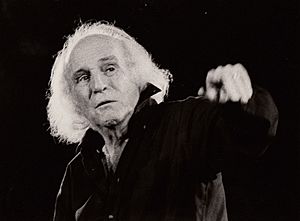Chanson facts for kids

The word Chanson is French for "song." When people talk about chansons in music, they usually mean songs with French words. Often, it refers to songs where French lyrics (the words) were put to music by classical composers from France.
Sometimes, "chansons" specifically means the French songs that were popular in the late Middle Ages and during the Renaissance period. People who sang these chansons were called "chansonniers." These old songs had different structures, like the ballade, rondeau, and virelai. Composers back then enjoyed taking popular poems and turning them into songs. The earliest chansons were written for two, three, or four voices, with many being for three voices. By the 16th century, most were for four voices. Sometimes, singers were joined by instruments.
Contents
Early French Chansons
The first important composer of chansons was Guillaume de Machaut, who lived in the Middle Ages. During the Renaissance, composers like Guillaume Dufay and Gilles Binchois wrote many simple chansons. Later, Johannes Ockeghem and Josquin des Prez created chansons where the voices copied each other a lot.
Clément Janequin wrote simpler chansons where all the voices moved together (this is called homophonic music). He worked near Paris. Later composers, such as Orlande de Lassus, were inspired by the Italian madrigal (another type of song). The style of chansons also started to be used in music made just for instruments.
The very first book of sheet music printed using a special machine with movable type was called Harmonice Musices Odhecaton. It was a collection of 96 chansons by many different composers. This important book was published in Venice in 1501.
Chansons with Instruments
During the 16th century, French songs began to be composed with lute or keyboard accompaniment. This means an instrument played along with the singer. In the 19th century, many composers wrote songs with piano accompaniment. These chansons were often called mélodies.
Popular French Chanson Today
In France today, "chanson" often refers to the music of popular singers. Some famous examples include Georges Brassens, Jacques Brel, Édith Piaf, Camille, and Olivia Ruiz.
Many French chansons by Jacques Brel have been translated into English. They are performed by Arnold Johnston, a professor at West Michigan University. Also, more than 100 chansons by artists like Brel, Brassens, Barbara, Bécaud, Ferrat, Aznavour, Trenet, and Ferré have been translated into German. These are performed by a duo called Stéphane & Didier.
Other pages
See also
 In Spanish: Chanson para niños
In Spanish: Chanson para niños

